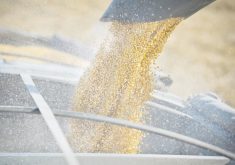Many grain industry analysts say ethanol’s growth phase is over and so is its ability to bolster grain prices.
Bruce Rastetter, chief executive officer of Summit Agricultural Group, an agricultural investment firm headquartered in Alden, Iowa, vehemently disagrees.
“They’re just wrong,” he said.
He points to new ethanol-promoting policies adopted by countries including China and Brazil as proof that the ethanol era is alive and well.
Even the Canadian government is considering doubling its national mandate to 10 percent, which is the portion of the fuel supply that would have to contain ethanol.
Read Also

Canadian Food Inspection Agency extends chronic wasting disease control program consultation deadline
Date extended for consultation period of changes to CWD program
“I think it’s a second wave of ethanol demand,” said Rastetter.
The first wave was created when the United States Congress adopted the renewable fuel standard in 2005, establishing national mandates for blending of the fuel.
That policy helped support corn and other grain prices until the market took a downturn in 2013 and has yet to recover.
Many grain industry participants such as Glen Pownall, managing director of Peter Cremer Canada Ltd., say the days of biofuel mandates propping up grain prices are over as influential players such as the U.S. and the European Union have taken steps to cap crop-based biofuel production.
“That’s the problem, you just really don’t have any growth in the world. Everything is kind of going backward for biofuels,” he said.
“We’ve had tremendous growth in that sector for so many years but now it seems to be plateauing.”
Rastetter said that is not the case and that ethanol is still very much in a growth phase in other places around the world.
Brazil is a good case in point. The government recently approved the RenovaBio program, legislation that will double the country’s renewable fuel use by 2030.
That legislation helped Summit Agricultural Group decide to invest $100 million in expanding its FS Bioenergia plant in Mato Grosso, which is already Brazil’s largest corn ethanol facility.
The expansion will more than double the plant’s ethanol production to 530 million litres from 227 million litres annually. Construction will be complete in the first quarter of 2019.
The plant is expected to process more than 50 million bushels of corn annually once the expansion is complete.
Justin Kirchhoff, Summit’s investment manager for the Brazilian operation, said the RenovaBio program applies to any type of ethanol but he believes corn ethanol will triumph over sugar cane ethanol because with double-cropping corn now common in Mato Grosso the cost of production is much lower for producing corn ethanol.
Brazil produced 28.4 billion litres of ethanol last year and will easily double that some time between 2022 and 2030 due to the new program, he said.
That would create a new annual market for 2.7 billion bushels of corn if all of the new capacity is corn ethanol.
China has also announced an ambitious plan to adopt a 10 percent ethanol blending mandate by 2020.
Bryce Knorr, senior grain market analyst with Farm Futures, estimates China’s mandate will create an annual market for 1.1 billion bu. of corn, up from the 235 million bu. being consumed by its ethanol sector today.
“China has to ramp up its ethanol industry from very little to a whole lot in a short period of time,” he said.
Reuters estimates China’s mandate will require the construction of 36 big new plants each producing 379 million litres of ethanol a year.
Knorr is uncertain what impact the mandate will have on corn and other grain and oilseed prices because it is unclear exactly how much ethanol production China already has and how quickly it can build the new plants.
He predicts China will initially have to import ethanol from the U.S. to meet its mandate. There is plenty of idle ethanol capacity in the U.S. and when that is used to supply the new Chinese demand it should bolster U.S. corn demand by a few hundred million bu. per year, which would be supportive for prices.
Other analysts believe China’s new mandate will have little to no impact on prices because the government will divert corn from its massive stockpile into the ethanol sector.
Rastetter believes analysts are over-thinking everything.
“I struggle why people think that’s hard to figure out because any additional use of corn, which clearly this is, helps strengthen the corn market and will continue to,” he said.
Knorr does not believe that a second wave of ethanol demand coming from places like Brazil and China is going to bolster grain prices.
He thinks the new source of demand will simply help mop up a portion of the nearly eight-trillion-bu. global stockpile of corn, which will help ensure the market has bottomed out.
But he isn’t holding his breath for another bull run to $8 per bu. corn any time soon. That is because global corn production has dramatically changed since the first wave of ethanol demand.
There is far more corn being produced in places like the Black Sea region and plenty of potential there for even more acres and better yields.
“You’ve seen an explosion in corn production. People around the world are learning how to grow corn the same way we do in the U.S. and Canada,” said Knorr.
















